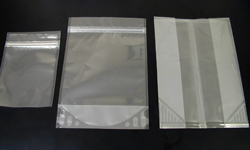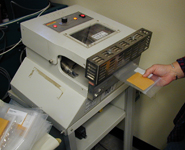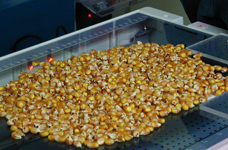| Storage Conditions |

|
|
1 - Station Information
2 - Storage Conditions 3 - Germplasm Lifecycle 4 - Crops Curated 5 - Ordering Germplasm 6 - Station Tours |

According to recommendations by the FAO/IPGRI's Genebank Standards (1994), long-term base collections should maintain seed storage conditions at -18°C. The use of sealed, moisture-impermeable containers was also recommended. For medium-term, active collections, the only recommendation given was to utilize conditions that ensure accession viability of at least 65% for a period of 10 to 20 years. The lack of more specific recommendations reflects recognition of the variability of appropriate seed-storage conditions for the wide range of species that are stored from site to site. The North Central Regional Plant Introduction Station is an active site. Our original seed samples are stored under long-term, base-collection conditions (i.e. -18°C). Seeds of our active collection, comprised of those samples that are regularly distributed to requesters, are stored at 4°C and 30% relative humidity, as described in greater detail below.Two storage condition regimens are utilized at the NCRPIS:
For Distribution (Active) Collection
For Original Seed Collection
- 4°C at 30% RH
- Seeds are initially dried before being placed in cold storage and are allowed to equilibrate further in cold storage before being placed in glass or plastic jar packaging. Changes to the seeds moisture content during the opening and closing of jars, which occurs during the filling of seed orders, is not a concern as the storage room's relative humidity is controlled at 30%. Glass jars are used instead of plastic for those taxa with small, electrostatically charged seeds to facilitate order filling.
- Under these conditions:
- Water is at its densest; cellular damage is reduced if we should unexpectedly store high-moisture content seed.
- No freezing damage can occur.
- The temperature is more tolerable to personnel filling orders than is the -18°C environment.
- Seed-longevity studies of Brassica, Cucumis, and Zea mays have shown average seed viability greater than 65% for 25 years for all three genera. Some samples of Zea mays maintained an average viability greater than 65% for 40 years. These durations exceed the recommendations of the FAO/IPGRI's Genebank Standards (1994).
- -18°C (relative humidity not controlled).
- Seeds are dried before being placed in freezer storage.
- Seeds are stored in re-sealable, thick-plastic, see-through packaging. This packaging is highly impermeable to air and moisture. The plastic packaging allows visual examination of the seed without having to open the package.
Reference:
FAO/IPGRI. 1994. Genebank Standards. Food and Agriculture Organization (FAO) and the International Plant Genetic Resources Institute (IPGRI), Rome, Italy.
Images:
Cold room for distribution lots.
One-gallon (3.785 liter) plastic jars.
One-quart (0.986 liter) glass jars.
One-pint (0.473 liter) glass jars.
Thick plastic resealable packaging.
Freezer-stored seed.
Package heat sealer.
Image scan of seeds.
Fire suppression air tanks.The fire suppression air is composed of nitrogen, argon, and carbon dioxide. When smoke is detected, the air is dispensed into the rooms in specific quantities for the size of the cold room and freezer rooms and brings the level of oxygen to just under 15%. This is enough oxygen for people to breathe, but insufficient to sustain a flame.
| << Previous 1 [2] 3 4 5 6 Next >> |









